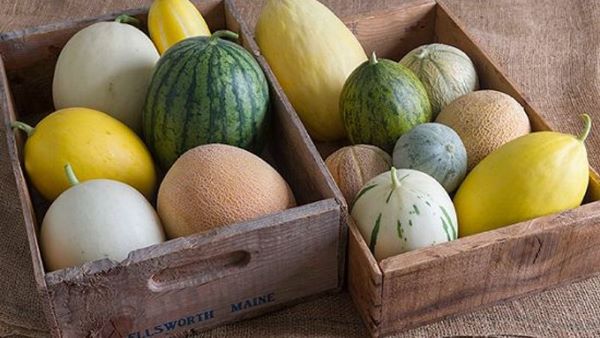Melons are a popular summer fruit in India, known for their refreshing taste and high water content. Various types of melons are cultivated across the country, each with unique characteristics and flavors. In this article, we explore some of the most prominent varieties of melons in India, including their origins, history, where they are found, availability, and unique properties.
Contents
1. Musk Melon (Kharbuja)
- Origin: India
- History: Cultivated since ancient times, musk melons have been mentioned in early Sanskrit texts and have been a part of Indian agriculture for centuries.
- Found in: Punjab, Haryana, Rajasthan, and Uttar Pradesh
- Availability: April to August
- Unique Property: Known for their sweet, fragrant flesh and netted skin. The flesh ranges from orange to green, and the fruit is rich in vitamins A and C.
2. Watermelon (Tarbuj)
- Origin: Northeast Africa, introduced to India centuries ago
- History: Watermelons have a long history in India, being a popular summer fruit due to their high water content and refreshing taste.
- Found in: Andhra Pradesh, Karnataka, Tamil Nadu, and Maharashtra
- Availability: March to July
- Unique Property: Known for their high water content (over 90%), sweet taste, and vibrant red flesh. Watermelons are also rich in lycopene, an antioxidant.
3. Winter Melon (Ash Gourd/Petha)
- Origin: Southeast Asia, including India
- History: Used in traditional Indian medicine and cuisine for centuries, particularly in the preparation of sweets like petha.
- Found in: Uttar Pradesh, Bihar, West Bengal, and Odisha
- Availability: Throughout the year, with peak season in winter
- Unique Property: Known for their large size, waxy exterior, and white flesh. Often used in Ayurvedic medicine and for making sweets.
Also, read: Dates Health Benefits: Nutritional Value and Uses
4. Honeydew Melon
- Origin: West Africa, widely cultivated in India
- History: Introduced to India through trade and has become a popular fruit in local markets.
- Found in: Punjab, Haryana, and Rajasthan
- Availability: April to August
- Unique Property: Known for their smooth, pale green skin and sweet, juicy, greenish-white flesh. They are rich in vitamin C and potassium.
5. Cantaloupe (Rock Melon)
- Origin: India and Africa, with ancient cultivation records
- History: Grown in India for centuries, often associated with hot summer months.
- Found in: Tamil Nadu, Andhra Pradesh, Maharashtra, and Punjab
- Availability: April to July
- Unique Property: Known for their rough, netted skin and orange, aromatic flesh. Cantaloupes are rich in vitamins A and C.
6. Snap Melon (Phut/Madhu Kheti)
- Origin: India
- History: An ancient melon variety, traditionally grown in various parts of India.
- Found in: Punjab, Haryana, and Rajasthan
- Availability: April to July
- Unique Property: Known for their ability to split open (snap) when ripe, revealing sweet, aromatic flesh. They have a high water content and are very refreshing.
Also, watch web stories: What is the Best Time to Eat Dry Fruits?
7. Bitter Melon (Karela)
- Origin: India
- History: Used for centuries in traditional Indian medicine and cuisine for its bitter taste and health benefits.
- Found in: Maharashtra, Uttar Pradesh, Bihar, and Kerala
- Availability: Throughout the year, with peak season in summer
- Unique Property: Known for their distinct bitter taste and unique texture. Often used in Indian cuisine and Ayurvedic medicine for its health benefits, including blood sugar regulation.
Nutrition Chart of Melons
Melons are not only delicious but also packed with essential nutrients. Here’s a general nutritional profile of melons per 100 grams:
| Nutrient | Amount |
|---|---|
| Calories | 34 kcal |
| Carbohydrates | 8.2 g |
| Sugars | 7.9 g |
| Dietary Fiber | 0.9 g |
| Protein | 0.8 g |
| Fat | 0.2 g |
| Vitamin A | 169 µg |
| Vitamin C | 36.7 mg |
| Vitamin E | 0.1 mg |
| Vitamin K | 2.5 µg |
| Potassium | 267 mg |
| Magnesium | 12 mg |
| Phosphorus | 15 mg |
| Folate | 21 µg |





